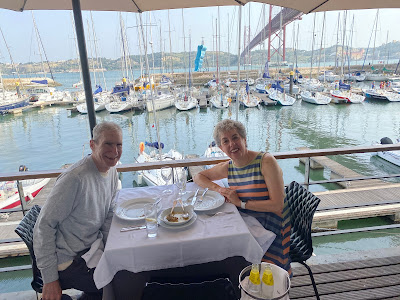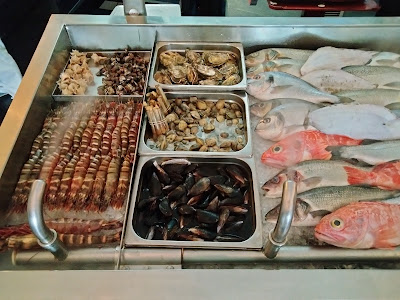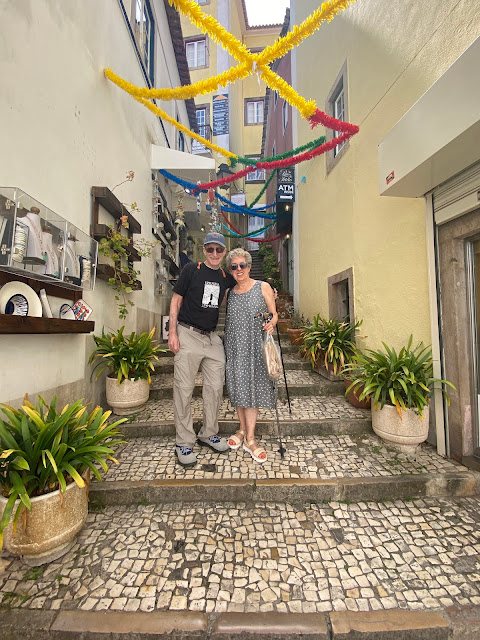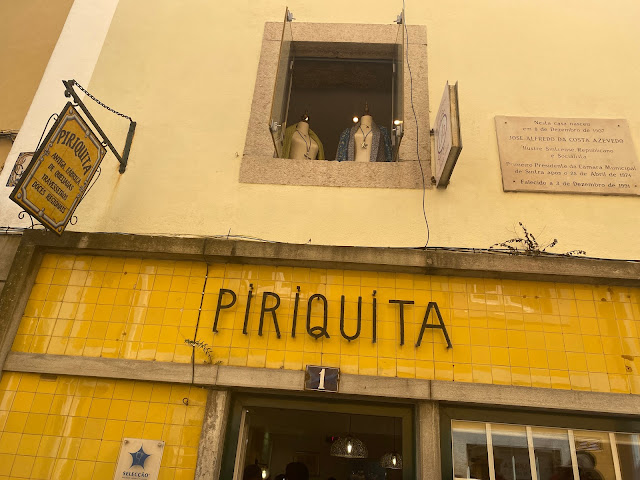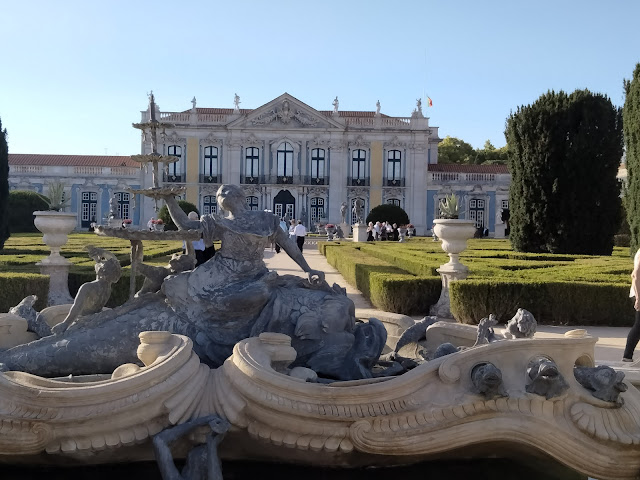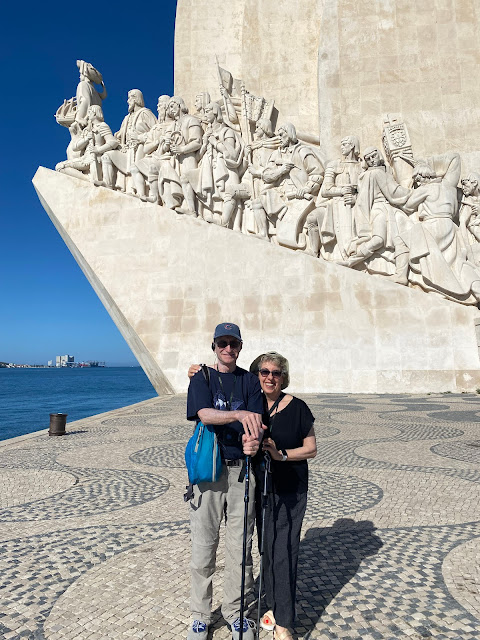Wednesday, August 9, 2023
The Tauck tour starts tonight with the standard welcoming dinner. Although with this group of about 60 people, it may be slightly different than we are accustomed to (our groups are normally about 15 - 25 people). So to fill the day we had previously booked a day tour through Tours By Locals. We have used them in other places and the tours are always top notch.
Our tour guide, Gloria, picked us up at 9:30 and we headed north to Sintra. This ENTIRE TOWN is a UNESCO World Heritage site, due to its collection of castles, palaces, and its special ecosystem (the first place to be recognized as a UNESCO World Heritage site for its ecosystem).
Sintra has seen occupation by the Romans, the Moors, and even an attempted invasion by Norwegians, until it was finally taken once and for all by Alfonso Henriques in 1154. Much of the town was severely damaged by the massive earthquake in 1755.
The two main attractions now are the Pena National Palace and the Sintra National Palace. Both started as summer homes for the royalty, and were added to and remodeled over the centuries. We only had time to visit one. Gloria explained that the former (the model for the Cinderella castle in Germany) has that "this is a palace" look from the outside, but the inside is rather plain. The latter, is not so impressive from the outside (except for its two 100 meter tall massive chimneys), but the inside is quite impressive. So (despite Wendy's FOMO concerns), we went for the latter. This palace was originally built in the 15th century.
Yes.....those are chimneys!
Here we are standing in an archway near the entrance. On the top of the hill behind us is the Moorish castle.
Gloria explained that technically a "castle" is the wall or fortification, and the "palace" is where the royalty actually lives. We tend to use these words interchangeably
For a hundred years or so, this palace was the center of economic and legal administration throughout the region. As we noted in yesterday's post, tiles are big in Portugal. So as you might expect in a palace, nearly every room we visited (and some of the outside walls) had beautiful tiles on the walls. Many were geometric patterns, others featured leaves symbolizing the various plants in the area, and others were like giant mosaic paintings!
We learned that most of the tiles are 14 cm square. Why? In the old days, you didn't order say, 100 tiles. You would order sheets of clay by the meter. 14 x 7 = 98, which is almost 100cm (e.g., 1 meter). So you could get 49 squares out of that.
Here are some examples:
This is "The Magpies Chamber", because of the 136 magpies painted on the ceiling. The story behind this is that King Joao was once caught in the act of kissing a
lady-in-waiting by Queen Philippa and to put a stop to all the ensuing
gossip he had the room decorated with as many magpies as there were
women at the court (136) with the immortal words por bem (for honor) written over their beaks! Those wacky kings!!!
This tile is one made using the "relief" technique, where the glazing colors (made from natural elements such as copper and iron oxide) were applied to the raised areas.
The next group of pix is from the Heraldic Hall, deigned by and for King Manuel I.
Remember: all of these were made by hand! Truly impressive
These next photos are from "The Water Grotto". This is a small building off of an outside courtyard. The courtyard itself had a shallow pool, but that was mostly used for the cooling effect of the water as opposed to actual swimming. So the royals and their guests would go into this room. Why? It may be hard to see, but there are hundreds of holes in these tiles, and water would be pumped through these to create what we might call a spa shower! Just imagine!!!!
We left the palace and walked into the town itself. Yes...one of those medieval towns with the narrow winding "streets" (all cobblestones of course!).
And, the "Jewish Street"--the only remaining sign of the Jewish population in Sintra. (More on the Jewish history of Portugal after our Thursday afternoon tour.)
We had been told by many people that the special thing to eat in Portugal is the pastries. There are so many different fillings. Too many to try to remember, so here is a post from another blogger that has already done so. So we HAD to stop in at Piriquita....a bakery that has been turning these out since the 1830s. That is not a typo....1830s!
Our driver Andre treated us to a half dozen queijadas (almond egg custard cookies; top left in the photo). They were amazing.
A final view of the palace as we drove out of town.
We then drove toward the ocean. It was about a 20 minute ride. In the time of the monarchs, this would have been an 8 hour carriage ride.
The most notable point here is Cabo da Roca (Cape Roca). This is the westernmost point of continental Europe.
Hard to see from where we were, but there is a lighthouse at the top, one of several along this part of the coast.
We drove farther along into the town of Cascais (in Portuguese, it is pronounced cahsh-cah-eesh). This town also started as a seaside retreat for the royals and nobility, in this case King Luis I in the 1870s. It is now a resort town and has one of the highest cost of living and real estate markets in the country.
Here is a photo of some nobles currently visiting:
Then it was back to the hotel to get ready for the kick-off dinner. Along the way, we asked Gloria about the Portuguese language. She said it has 7,500 different sounds...way more than English. She explained some of the rules...."s" between two vowels has the "sh" sound....you can't have 3 consonants in a row (like we do in "street")...and lots of different vowel sounds. The alphabet has 23 letters, no "w", no "y" and surprisingly, no "k". So we would be Ouendi and Ouaine!! Languages are so much fun.
Our Welcoming dinner was at the Queluz (Quel-ooz) National Palace. This was the last great Rococo building built in Europe (mid-eighteenth century). It was another summer getaway place for the King and his court. It is often referred to as "the Portugal Versailles". And it is the venue of choice when foreign dignitaries visit. Because the "usual suspects" (kings, queens, prime ministers and presidents) weren't in town, we were able to have our reception here. The grounds and gardens were stunning, especially as we walked around and were offered hors d'ouevres and drinks!
The dinner was a typical Tauck food-a-thon....way too much....pretty tasty, but not picture worthy. And, as is the custom in these parts, food was not served until 8 pm! How in the world did we even stay up until 10:30?
Til next time,
love w&w.............






